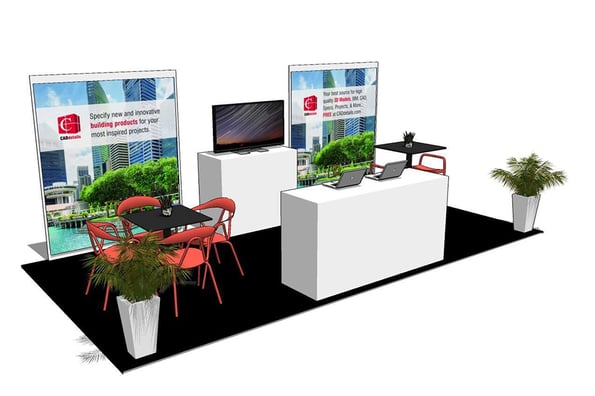Trade show exhibiting can give businesses the opportunity to connect face-to-face with clients and prospects they may never otherwise have the chance to meet. Exhibiting can have a big impact on your company’s sales, but you may also walk away from a trade show with losses and frustration. Planning is key to a successful trade show, and knowing your goals will help you organize your time and budget in a manner that will benefit your sales and customer relationships. Building product manufacturers can meet a range of designers, contractors, architects and engineers at a show, but success is not guaranteed.
You and your company should plan to help you when you are deciding if you should take on the expense of exhibiting at a show. Some of the elements to explore are: travel, booth space and budgeting, staffing requirements, branding and marketing, attending or hosting trade show events, and pandemic considerations. Below we discuss some of the things your trade show team will need to review.
1. Travelling to the Show
Travel comes with expense and risk. Travel costs vary by destination, mode of transport, and time of year. When flying, there is a temptation to book the lowest priced flights, but take more than cost into account. Flights may have delays and cancellations, so you may want to consider a buffer of time to ensure your team arrives with enough time to set up your booth and be ready for a strong show. Tight flight schedules can risk missed connections. If your team only has one hour to catch a connecting flight, any delay of their first flight could cause problems that may result in arriving later than desired.
Issues with lost baggage can arise, and this may include key elements of your exhibit if you are bringing your booth exhibit with you on a flight. Try to allow for enough time for your team to sort out issues that may come up with lost baggage. While you may want to ship your booth contents, this can be a large expense. There is also the added expense of the loading fees at the show for shipped items. This is an important consideration particularly for building product manufacturers as products may be large and heavy, adding to shipping costs.
Travel arrangements may also be needed when you arrive at your destination city. Many shows do offer shuttles to and from the show for selected hotels. If you are relying on shuttle service, find out which hotels have shuttle service when you are booking. For some shows, you may also want to consider renting a vehicle to transport your team.
💡 Tip: Research all potential travel and shipping costs when deciding if trade show exhibiting is the right path for your company and your products.
2. Your Booth
Trade show booths average between $20 and $50 per square foot of exhibit space. Typically shows have a minimum booth size of 10 foot by 10 foot, so this 100 square foot space can cost $2,000 to $5,000 USD for the smallest booth option, and that does not include all of the additional booth expenses such as furniture rental, electrical and data hookups, carpeting, and so much more. To maximize the impact your booth makes on the floor, list out what you want your booth to do for you. Are you hosting meetings? Will you have products to showcase? Do you have samples to hand out to architects and designers? Are you providing literature? How effective is your branding? Are you collecting leads? Are you planning to make sales at the show? Will you be taking orders? How large does your booth need to be to serve all desired functions? Are you able to secure a good location on the show floor? These are all questions to ask yourself before attending a trade show.
Once you have a list of your priorities at the show, lay out your booth space accordingly. You will most likely be renting furnishing at the trade show, and these expenses add up quickly. Determine your ideal layout and explore what options are available within your budget.
💡 Tip: Plan ahead and consider EVERYTHING!

3. Staffing at a Trade Show
The most important piece of the trade show puzzle is undoubtedly the team you send. A great team is needed for a successful show. Your team needs to be knowledgeable about your products, and able to answer most of the questions design professionals will be asking. Trade Shows are hard work for exhibitors, but they can be energizing and invigorating too. A great attitude goes far at a show, so select team members that are eager to go, good representatives of your company, and can solve problems under pressure.
An eager team is key, and you will want your booth staffed by people that really want to be there. Trade shows require staff to travel away from their family, face a rather extended work day, and take on additional tasks around preparing for the show and following up after. The workload prior to a show can be intense, and tasks take people away from other duties. The travel also takes people out of the workplace and this may cause delays in other areas.
Your staffing plans must include a budget for food and potentially entertainment. We all need to eat, and exploring new restaurants can be a great way for your team to connect and recharge. Make sure your staff has a per diem allowance appropriate for the destination city. Some cities are more expensive than others, so make sure everyone is prepared. You may also want to consider planning evening outings for your team. They have sacrificed some part of their daily lives to represent your company at a trade show, so a break from the intensity of the show with an evening out will be appreciated.
💡 Tip: Do research on the destination city, and have fun!
4. Branding & Marketing
There will be many opportunities to grow your name at a trade show, from simple email campaigns you run to let clients and prospects know you will be exhibiting, to large budget sponsorships to increase visibility on the show floor.
Before trade shows, you have opportunities to advertise around the show by creating email campaigns. If you are releasing a new product, let people know they should visit your booth to check it out. The show itself may sell email campaign spots, and trade publications that are at the show may be running trade show specific issues. Online services may also offer additional exposure around trade shows.
Plan to have effective branding at the show. Brand your booth in an effective and inviting way so that attendees walking by feel welcome and drawn in. Your booth space is just the start of your branding options. Your staff may show off your brand in a variety of ways including pins, shoes, entire outfits, branded t-shirts, ties, cardigans, blazers, and even shoes. Each trade show will have ways for you to get your name out at the show beyond your booth space.
Trade show giveaways can give attendees something with your name on it that they make take home. If you do put your name on something you hand out at the show, try to make it something that will make it into attendees’ carry on luggage. If you choose to put your name on something like a pen, make it a pen that writes well and feels good in the hand so people hold on to it. During the current pandemic, considerate trade show giveaways may be masks or hand sanitizer or moisturizer.
As building product manufacturers, try to think of a creative way to give attendees something to take home that makes them think of your product. Tiny models of your product or useful tools related to your product, items finished with a special coating related to your product or some other means of connecting your building product to their trade show swag can keep you in their mind and even on their desk for a long time.
💡 Tip: Make yourself memorable at the trade show.
5. Events
Ahead of a show you are likely to receive information about related events. These may be keynote speaker sessions, educational events, evening events and galas, city tours and more. When planning your itinerary, decide which events could benefit you at the show, and which ones your team would enjoy. Some events offer networking opportunities, while others will be more for education or entertainment. Remember what you want to achieve when deciding on events to attend.
There will also be opportunities to host or sponsor events. You may want to make product announcements in a meeting room at the convention center, or host coffee or happy hour events on the trade show floor. What fits best with your goals?
💡 Tip: Networking at the show can be just as important as preparation for the show. Get your team out there, show attendees and other exhibitors what you got!
6. Pandemic Considerations
At the time of writing, it is currently fall of 2021. Trade shows have resumed, but there are pandemic considerations to take into account. The COVID-19 pandemic impacts all of the above sections.
For your staff, you will need to consider requiring them to be fully vaccinated. The trade show venue may require proof of vaccination to attend. At CADdetails, our trade show preparation for staff has included providing branded face masks, making hand sanitizer available at the booth, having staff wipe down all surfaces with disinfectant to adhere to health and safety protocols. Our booth staff will ensure proper social distancing and use tape to mark off designated areas. We are sending less staff to trade shows than we did pre-pandemic, so we have had to change how we send our gear. While we have previously taken most items with us as checked baggage, there is too much baggage to handle for the small team we are sending so some items will be shipped to the hotel before the show.
The pandemic has also shifted marketing and branding around shows. Making branded pens available at your booth ensures everyone has their own writing implement while also giving attendees an easy way to carry your name home. Giveaways and swag can be laid out and presented in such a way that they are easy for attendees to take without having to get too close to your staff.
During the pandemic, ensure that any events you want your team to attend can accommodate your team. Some events typically held around shows may not be taking place yet, and others may have limited capacity. If an event is important to you, look into it before the show and make sure your team is ready.
💡 Tip: Trade shows in 2021 and even into 2022 may look different than previous years, so be adaptable. Everyone is new to this, you’re not alone!
Conclusion
Make sure each and every show you commit to is worth the effort and expense. The trade show planning itself is a large task, but a task worth doing well. A well thought out trade show presence can make the difference between a successful show, and a waste of time and resources.
If you decide to exhibit, track your show generated leads so you know if you should return in future years. And most importantly, have fun!
Learn how to increase awareness about your building products by talking to one of our experts! CADdetails has been exhibiting and attending trade shows for over 20 years and we'd love to share more tips on how to make a trade show successful for you and your company.

